|
Balda-Werk is a company with a long history that started with its founding in 1908 by Max Baldeweg in Dresden. Initially it produced camera parts, but in 1925 it introduced its first box camera and in 1935 the Baldina, a folding 35mm camera. After WWII Max Baldaweg restarted its company in former West-Germany, as the Dresden factory was confiscated by the authorities. The Dresden factory continued producing the Baldina cameras under the Balda brand, but was in 1951 renamed Belca. Camera production in West-Germany continued with pre-war as well as new models, including non-folding cameras. It kept producing cameras until the 1980s, although the last 20 years mostly simple instant cameras. The company reshaped itself and Balda AG still exists as a company specialising in plastics.
Juwella
Like many German camera makers in the era between WWI and WWII, Balda started with relatively simple box and folding cameras. The Juwella was an example of the latter. It was a 6x9 format camera for use with 120 film and featured a simple frame finder as viewfinder as well as an old-school brilliant finder next to the shutter. The camera was usually equipped with simple self-branded lens and shutter, although later models were available with lenses and shutter of higher spec. Folding cameras from different brands from this era all looked rather similar and aren't always easy to identify, especially if they are unbranded models sold under different names, a practice that became more and more common at the time. Generally, I find that it is the shape of the folding struts that are the most reliable indicator of which company made the camera.
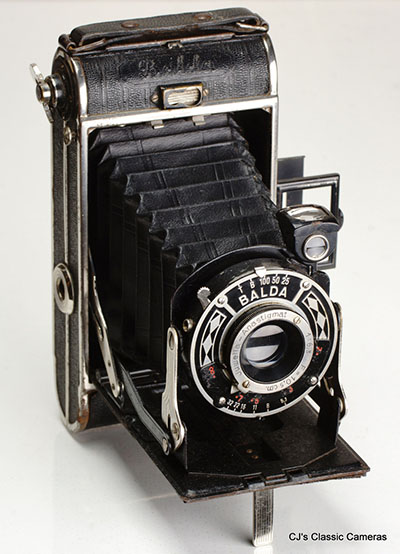
| |
A Balda Juwella with Juwella-Anastigmat 105mm f/6.3 lens in unbranded three-speed Art Deco-style shutter, which suggests this is probably a 1936 model. Note that the shutter decoration is partially covered by the focus and aperture scale. I haven't removed this cover but I suspect Balda used the same shutter plate for different apertures and lenses, and added these cover plates when needed.
|
Balda Piccochic
The Balda Piccochic was a bit of an outlier in the Balda line-up, which at the time (early 1930s) mostly consisted of fairly standard folding and box cameras. However, the Piccochic had a pop-out front. Not totally unusual for the time, e.g. there were the Merkel Metharette and Korelle 3x4/Meyer Megor. I think this was probably Balda's first 127 format model and maybe it was this model that made them decide to no longer pursue this style and designed the more mundane Balda Baldi further below on this page instead.
Whatever the story, the Piccochic was a small but stylish camera for 3x4 format. It fitted easily in your hand or pocket. My example has front-cell focsusing, but there are also variants with a focus lever and helical focussing. Like most Baldas, it was available with a wide range of lens and shutter combinations, including high spec Tessars and even an f/2.7 Meyer Makro-Plasmat has been seen.
 | |
An early Balda Piccochic with E. Ludwig Lausa-Dresden "Vidar" 50 mm f/2.9 lens (quite a feat to print all that info on a tiny lens) in Compur shutter. The shutter serial number indicates it was made in 1933, but only a few months earlier than the one on the Baldax below. |
Balda Baldax
The Balda Baldax was a 6x6 format folding camera for 120 rollfilm, and the start of a highly valued range of medium format Balda cameras culminating in the Mess Baldix and Super Baldax rangefinders, which can be found further below. The beginnings, however, were humble, as can be seen from the photograph below, showing a simple viewfinder camera lacking a body mounted shutter release and without fancy features like paralax correction. But this was the standard at the time, and the Baldax was clearly a well constructed camera with a very stable strut system and nice chrome accents. Somewhat unusual, but common for Baldas, was the bottom mounted wind knob. The Baldax was available with a wide range of shutter and lens combinations.
 | |
An early Balda Baldax with Vidanar 75 mm f/4.5 lens in Compur shutter. The shutter serial number indicates it was made in 1933. The lens was made by Ludwig in Dresden, better known for its Meritar lenses which were popular with east German camera makers in the 1950s and 60s. |
Rodenstock Robra (Balda Baldax)
Lens maker Rodenstock sold a large range of rebranded cameras, generally equipped with one of their own lenses. Some of the other ones on this site are the Rodenstock Citonette (a rebranded Welta Perle), the Rodinett (a rebranded Glunz Ingo) and the Ysella (a rebranded Zeca Goldi). The Rodenstock Robra was a rebranded Balda Baldax, a 6x6 format camera for 120 rollfilm. The Robra as well as its namesake the Baldax were nice folding cameras with sturdy struts and body-mounted shutter release, although the viewfinders were rather small and in my opinion no improvement over the earlier fold-up viewfinders.
 | |
The Rodenstock Robra shown here is equipped with a Robra-Anastigmat 75 mm f/2.9 lens in Compur shutter. The lens is interesting as it doesn't actually say it's a Rodenstock lens, but it appears be a renamed Trinar-Anastigmat such as found on e.g., the Rodenstock Citonette on the Welta page. However, the serial number doesn't match the Rodenstock lenses from that era (mid-1930s). The shutter is also a little enigmatic as it has a serial# starting with '00' which I've never seen before on a Compur. |
Baldi
The Balda Baldi was a very small camera which easily fitted in your hand made for 127 film 3x4 format. Thus, it was considerable smaller than the 35mm Baldini (see above), but it had in fact a nearly 40% larger film format. Like the Baldini, the Baldi had a parallax-adjustable viewfinder. Other than that it was simple to operate, having a single wind knob to wind the film, two spy windows at the back to check the frame number, and a shutter release near the hinge of the front door. Despite the difference in frame size, the same 45-50 mm lenses were used on the Baldi as on the Baldina, although I have not seen any Schneider Xenon versions.

A Balda Baldi with Schneider Radionar 50mm f/2.9 lens in Compur-Rapid shutter. This example is actually branded 'Novex', not Balda. I have not been able to find out anything about this name. In the UK some Baldas were sold under the name Westex by Westminster Photographic Exchange, London, so perhaps the Novex was sold by another, yet unidentified camera shop.
(left) Rear view of a Balda Baldi showing the 2 spy windows typical of 3x4cm 127 format cameras; (middle) interior of a Baldi showing the portrait orientation 3x4cm film frame; (right) top view of the Baldi
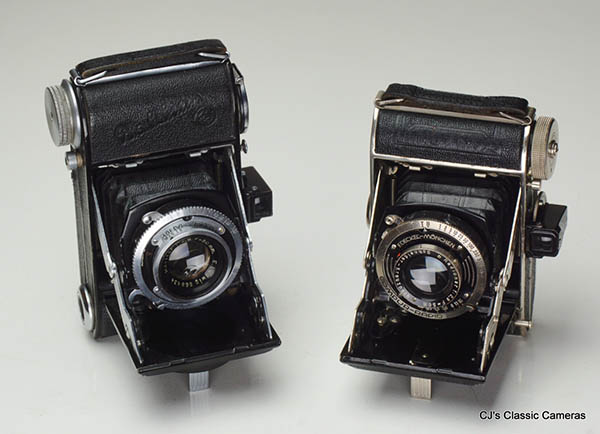
Comparison of a Balda Baldina (left) and Baldi (right). Note the much smaller size of the Baldi.
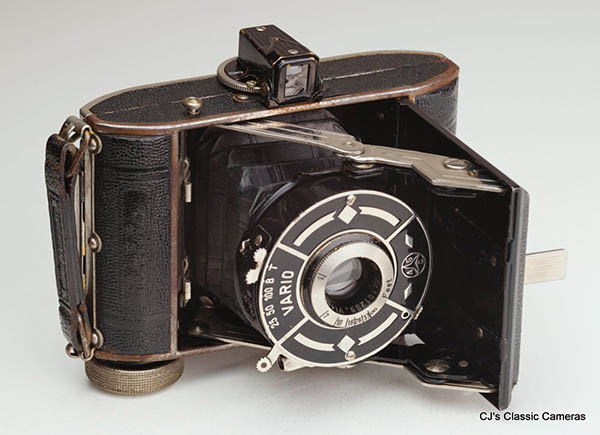
A different example of the Baldi with an Art Deco design Vario shutter and Vidanar f/4.5 lens. In addition, the wind knob is at the bottom of the camera instead of next to the viewfinder as on the example shown earlier. Its also lacking the door-mounted shutter release.
Balda Rigona 3x4
This camera looks very similar to the Balda Baldi above, but the name embossed in the leather is Rigona, the name Balda used for cheaper versions of their regular cameras. As such, I have seen this name on a variety of camera types, including 35mm folding viewfinders and rangefinders, as well as 3x4 folding cameras for 127 film such as the one shown here. This one is equipped with a Compur shutter, which suggest perhaps this in not the original shutter, which more like would have been a Vario or Prontor. Other than some small cosmetic details, the only difference I could find with the similar looking Baldi above is the parallax adjustment underneath the viewfinder, which is lacking on the Rigona.

A Balda Rigona 3x4 with (unbranded) Anastigmat f/2.9 lens in Compur shutter.
Baldina
The Balda Baldina was introduced in 1935 and was a 35mm folding camera not unlike the Kodak Retinas, but quite different functionally. It had a wind knob at the bottom which needed to be pulled out to rewind the film, and next to it was a button that needed to be pushed in to reset the wind lock after each exposure. The shutter release was located on the camera body next to the rewind knob, but it had no double exposure prevention. There were several variants, some even featured a helical focus mount and it was most commonly found with a Compur or Compur-Rapid shutter. It was available with a wide range of lenses, including Schneider Xenons and Carl Zeiss Tessars, but more commonly Schneider Radionars and Meyer Trioplans. A unique feature was the peculiar frame counter with its flip-open cover. The Baldina also featured a viewfinder that could be adjusted for parallax by a little turning wheel.

|
A folding Baldina with uncoated Ludwig Meritar 50mm f/2.9 lens in Ovus shutter. This example was produced in the East-Germany Dresden plant shortly after WWII, as indicated by its Ovus shutter, the Balda Dresden equivalent of the Compur shutter. The build quality of this one feels rather cheap, with abundant use of rather flimsy metal parts.
|
After WWII the Baldina was produced in the original factory in Dresden, East Germany, as well as in the new Bunde factory in West Germany. From 1951 onwards the Balda factory in Dresden was renamed to Belca, and the Baldina continued to be produced under the name Beltica. From here on it no longer featured the peculiar frame counter. The West-German plant also produced a number of usually less well specified variants such as the Jubilette, Baldalette, Baldini and Rigona.
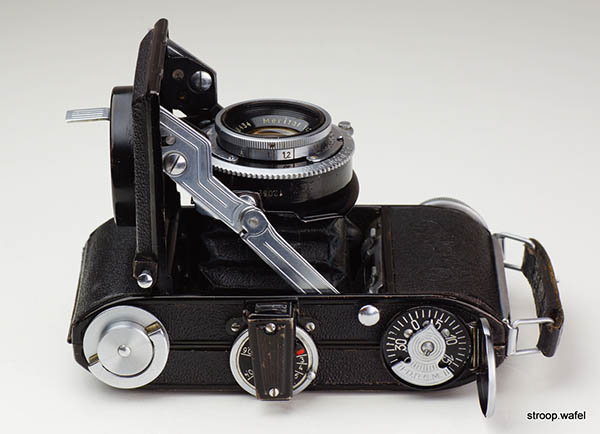
Top view of the folding Baldina, showing its quirky frame counter.
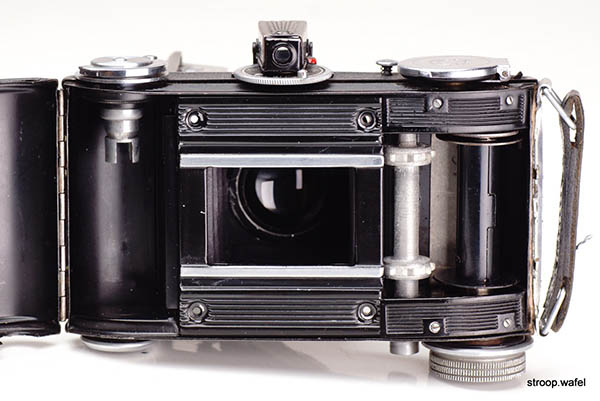
Somewhat curious about the Baldina camera is the 35mm film gate, which was essentially a metal mask screwed on top of what looks like a 127 film 4x3 film gate. There was in fact a 127 rollfilm camera made by Balda, the Baldi, which was very similar to the Baldini. It appears they were based on the same base chassis.
Jubilette
The Balda Jubilette was a cheaper version of the folding Baldina, although the differences were small. The Jubilette did not have the parallax adjustment that some (but not all) Baldinas had, and it had a less fancy frame counter. However, it came with similar lens and shutter combinations, except the more expensive lenses such as Tessars and Xenons (which to be honest were rare on the Baldina also). There were a few slightly different variants: early versions had a shutter release integrated in the front door, on later versions it was on top of the body.
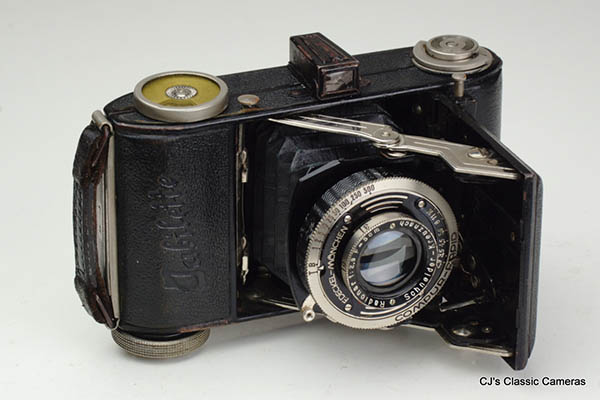
A Balda Jubilette with Schneider Radionar 50mm f/2.9 lens in Compur-Rapid shutter.
Baldaxette II
The Balda Baldaxette II was introduced in the mid 1930s and was a rather impressive camera for its time, it being a 6x6 format rollfilm camera with coupled rangefinder with parallax-corrected viewfinder, a unit-focussing lens and body-mounted shutter release. I can't think of any other cameras of that time with a similar impressive range of features, other than the Zeiss Super Ikonta. Early production had a black-leather covered top housing with a depth-of-field table mounted on top, whereas later production had a chrome-coloured housing with a depth of field table at the back. A 6x9 format version was also produced, which was known as the Balda Super Pontura. The Baldaxette II was available with a choice of fast lenses, such as an f/2.8 Xenar or Tessar, or an f/2.9 Trioplan. The name suggests a Baldaxette I was also available, but I have not been able to find much information about it, other than that it was a 6x4.5 format camera. I presume the Baldaxette must have been a rather expensive camera that sold in only limited amounts, as it very rare today, certainly compared to post-war Balda models.
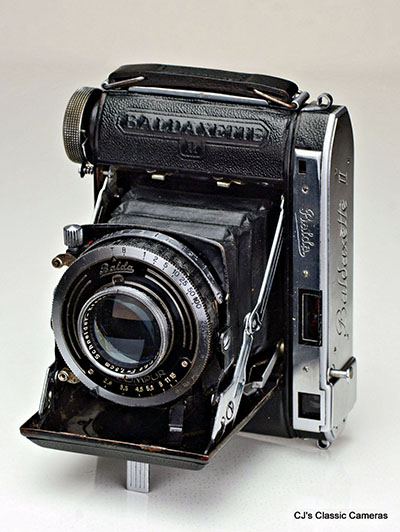
|
A 1938 Baldaxette II with Schneider Xenar 75mm f/2.8 lens in Compur shutter.
|
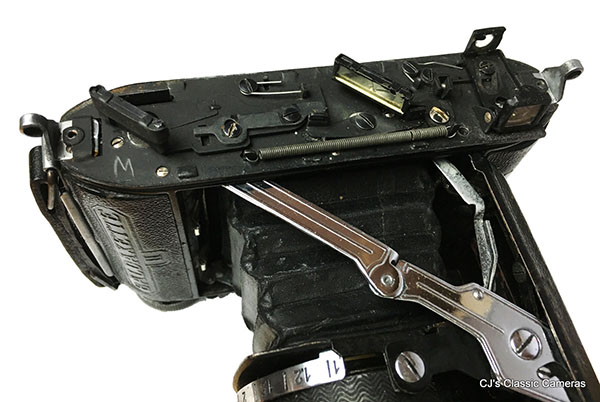
Top view of the Baldaxette II with top housing removed to show the rangefinder construction. .
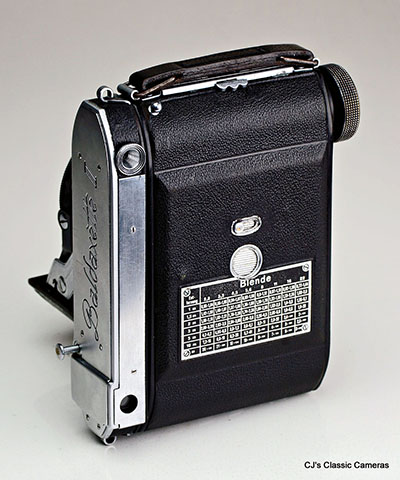
|
Rear view of the Baldaxette II. Note the two eyepieces and how far apart they are, the right one (top one in picture) for the rangefinder, the left (bottom) one for the viewfinder.
|
(Mess) Baldinette
The 1951 Balda Baldinette was very similar to later versions of the Balda Baldina with a chrome top cover that spanned the full width of the camera. It had a similar wind mechanism with a small button next to the wind knob that needed to be pushed to reset the wind lock after each exposure. A version with uncoupled rangefinder was called Mess Baldinette. It had separate viewfinder and rangefinder windows, the latter had a magnification of about 1.5 for more accurate focussing.
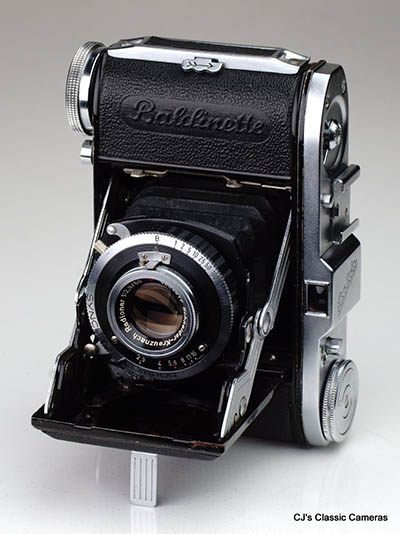
|
A Balda Baldinette with Schneider Radionar 50mm f/2.9 lens in Synchro-Compur shutter.
|
The Baldinettes were available with Baldanar f/3.5 and f/2.8 as well as Schneider Radionar f/3.5 and f/2.9. A cheaper version of the Baldinette was the Rigona, the main difference being the Rigonar f/3.5 lens found on the latter. A Mess Rigona with uncoupled rangefinder was also available. A more expensive version was the Super Baldinette (see next).
The Mess Baldinette was also sold as Hapo 35, including a version with three rectangular viewfinder windows without accessory shoe. The Hapo 35 had Enna-Werk Haponar lenses, which suggests that the Baldanar lens on the Mess Baldinette was most likely made by Enna also.

A Balda Mess Baldinette with Baldanar 50mm f/3.5 lens in Prontor-S shutter. The uncoupled rangefinder unit was mounted to the inside of the top housing and could be removed by unscrewing the front screw of the accessory shoe. Rather unusually, it operated by rotating the angle of the semi-transparent mirror and its construction differed substantially from the rangefinders on the Mess Baldix and Super Baldax below.
Super Baldinette
If you wanted something more fancy than the Mess Baldinette above, the Balda Super Baldinette may have been the camera for you, as it featured a coupled coincidence rangefinder as well as a unit-focussing lens. It is easily confused with the Mess Baldinette, but the latter had two round rangefinder windows, whereas the Super Baldinette had a square and a round one. Simples! It was available with top of the range lenses such as the Rodenstock Heligon, Schneider Xenon or slightly cheaper Enna Ennit and Schneider Xenar.

A Balda Super Baldinette with Enna-Werk Ennit 50mm f2/.8 lens in Prontor-SV shutter.
Mess Baldix
The 1954 Mess Baldix was the rangefinder version of the Baldix (after the German 'Messsucher' for rangefinder), a 6x6 camera that used 120 rollfilm. It had an uncoupled rangefinder, the knob on left of the camera (while facing it) was not a wind knob but the rangefinder wheel. After finding the right focus one needed to transfer the distance value to the lens focus ring.
Winding the film on this camera was rather unusual, one first need to turn clockwise as far as possible, then anticlockwise. There was a frame counter under the wind knob, so there was no need to use the spy window at the back. The (Mess) Baldix was available with various lenses, including a Baltar f/4.5, a Baltar f/2.9 and an Ennagon f/3.5, all of them triplets. The Mess Baldix was also sold as Hapo 66E by Porst.
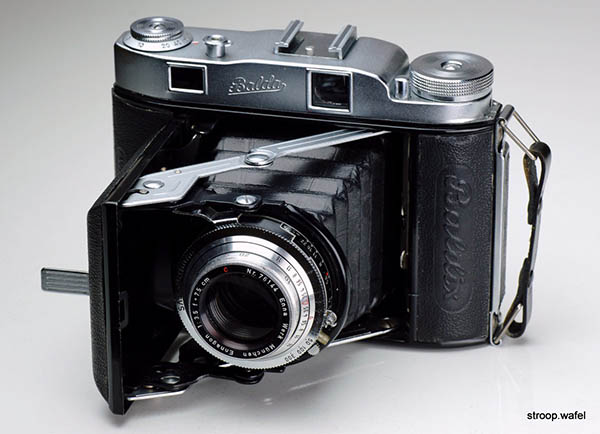
A Mess Baldix with Ennagon 75mm f/3.5 lens. For sample images see here

Mess Baldix with the top housing removed, showing the rangefinder unit. Turning the rangefinder dial (removed in this photo) will move the long lever to which the semi-transparent mirror is attached. Also visible is the wind lock mechanism. The metal button is not the shutter release button but the door release. The shutter release is on the left.
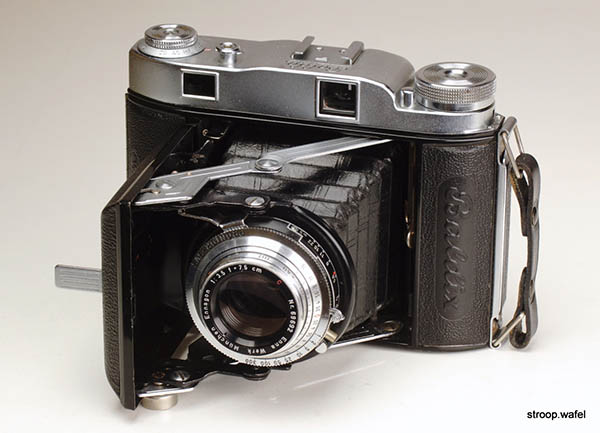
Slightly different version of the Mess Baldix, with Balda logo at the top instead of on the front and an accessory with screws visible. The two different versions appear to overlap (based on Ennagon lens nr.) so I am unsure why two different version were made.
Super Baldax
The 1954 Super Baldax was very similar in appearance to the Mess Baldix above, but featured a helical focussing mount and a coupled rangefinder. The distance dial knob was a depth-of-field indicator and did not set the rangefinder as on the Mess Baldix. The Super Baldax came with a slightly longer 80mm lens than the Mess Baldix, including a Baldanar f/3.5, Baltar f/2.9, Schneider Radionar f/2.9, Rodenstock Trinar and Enna Werk Ennit f/2.8. It was available with Prontor-SVS as well as Synchro-Compur shutter. It had a similar wind lock mechanism as the Baldix so there was no need to use the red spy glass at the back when winding the film.
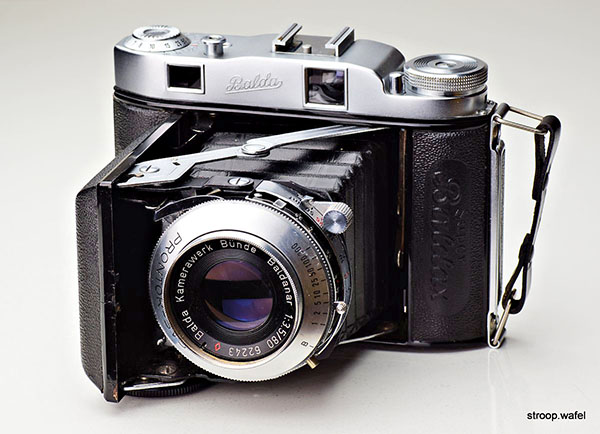
A Super Baldax with Baldanar 80mm f/3.5.

| |
A Balda Super Baldax with Enna-Werk Ennit 80mm f/2.8 lens in Synchro-Compur shutter, the highest spec model, and one of the few folding cameras available with such a fast lens. |
Balda Baldalux
The Baldalux was a 6x9 format rollfilm camera, some versions of which could also be used in 6x6 and 6x4.5 mode. It was a fairly simple viewfinder camera but did feature a double exposure prevention mechanism as well as a body-mounted shutter release. It had a chrome tophousing similar to that of the Balda Baldix (the non-rangefinder version). Like most Balda folding cameras, it was available with a wide choice of shutter and lens options to suit everyone's needs. Although a rangefinder version existed of earlier 6x9 Balda models (see the Super Pontura mentioned in the Baldaxette II section) and contemporary 6x6 models, I am not aware of a rangefinder version of the Baldalux.

A Balda Baldalux with Rodenstock-Trinar 105 mm f/3.5 lens in Sychro-Compur shutter, one of the top lens-shutter combinations the Baldalux was available with.

|
Rear view of the Baldalux showing the three different spy windows for 12, 16 and 8 exposures on 120 rollfilm, respectively. Also note the switch next to the viewfinder eyepiece to adjust it for the different frame sizes. This feature was not available on all Baldalux so I assume this could be ordered as an extra feature.
|
Beltica
After WWII Germany was divided into East and West, which left many camera makers stranded behind the iron curtain, including those in Dresden, the centre of pre-war camera and lens production. Therefore, many brands set up shop in West Germany, either by moving there or by expanding already existing branches. In quite a few cases, this led to brand name disputes between East and West-German branches, e.g., between Carl Zeiss and Zeiss Ikon. Due to export and import restrictions on camera components, most East German camera makers had to rely on East German companies for their lenses as well as shutters, as the two main shutter manufacturers, Deckel (of Compur shutters) and Gauthier (of the Prontor shutters), were both owned by Zeiss Ikon. Fortunately, they could get their lenses from the mighty Carl Zeiss in Jena, thus at least securing a source of high-quality optics.
Balda was one of the companies that relocated to the West after WWII, as its factories in Dresden had been nationalised. For a few years the Dresden factories still made Balda cameras, but a lawsuit forced them to change their name, which became Belca-Werk. From here on the camera lines of the two companies started to diverge, but in 1956 Belca was taken up in VEB/Pentacon, thus ending its brand name.
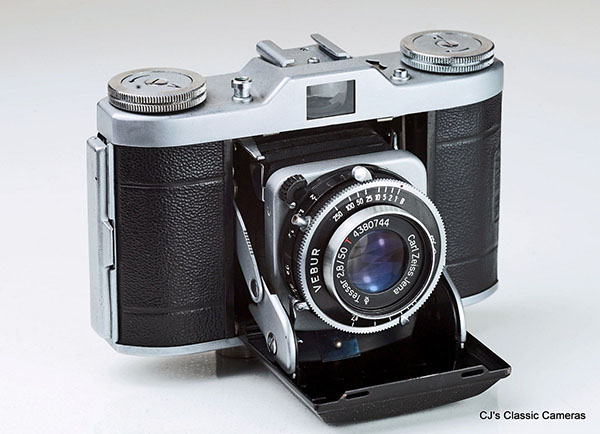
A Belca Beltica II with coated Carl Zeiss Jena T Tessar in Vebur shutter, a Compur-style shutter.
Both the East and West German Balda branches made Baldina camera as a continuation of pre-war production. The East German ones can be recognised by their Cludor, Ovus or Tempor shutters. They had Ludwig Meritar, Meyer Trioplan or Carl Zeiss Tessar lenses, but so did many of the pre-war Baldinas. In fact, my example of the Baldina further up in this page is an East German one. The Baldina was renamed Beltica once the company name changed in 1951. I have also seen it under the name Multina. The Beltica I was a completely different folding camera that looked a lot like the Certo Durata, whereas the Beltica II had a larger top housing with build-in viewfinder instead of the fold-up viewfinder of its predecessor. Both had a helical focus system and body-mounted shutter release, but no automatic shutter cocking.
Other cameras made by Belca were the Belfoca 6x9 folding camera, the Belplasca stereo camera, and the Belmira, a non-folding rangefinder, which continued to be produced by Welta after 1957, an example of which can be found elsewhere on this site.
Baldina
The name Baldina was recycled for the first non-folding camera produced by Balda-Werk, which was introduced in 1953. It was a rather large 35mm camera with collapsible lens mount and helical focus system. It came in several versions, with bright frame viewfinder, light meter or coupled rangefinder. The latter were initially called Super Baldina, but later Baldinas all had rangefinders and the 'Super' prefix was dropped. It was available with a wide range of lenses, but most commonly a Balda Baldanar f/2.8 or Schneider Radionar f/2.8. Finding one with a Schneider Xenon or Rodenstock Heligon f/2 would be a real treat! These were high-quality cameras introduced to compete with for instance the Agfa Karat IV.
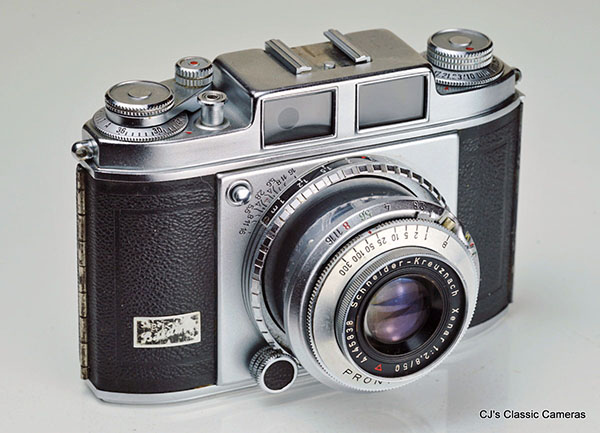
A Super Baldina from around 1955 with Schneider-Kreuznach 50mm f/2.8 Xenar lens in Prontor-SVS shutter, its lens tube extended.
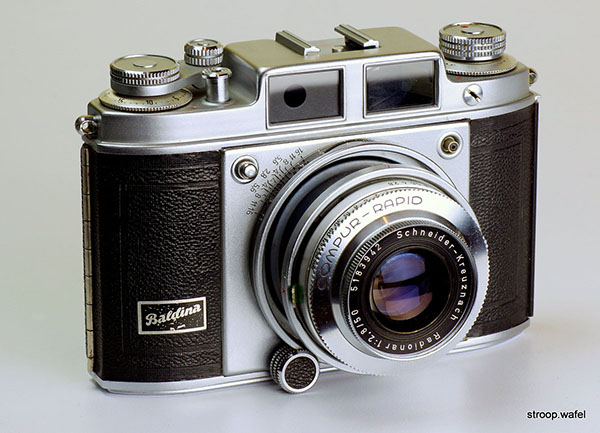
A later Baldina from around 1957 with coupled rangefinder and Schneider-Kreuznach 50mm f/2.8 Radionar lens in Compur-Rapid shutter. There's a few small cosmetic changes compared to the earlier version above, most notably the base of the lens mount, which changed from a scalloped to a smooth ring and the position of the flash sync socket.
Baldessa Ib
The Baldessa range was introduced in 1957 and was a series of non-folding 35mm cameras of various specification. Early models were simple viewfinders, but rangefinders with or without light meter were soon introduced. They had a rather unusual film wind mechanism at the base of the camera in the shape of a large key that needed to be twisted 180 degrees.
The Baldessa Ib was the first model with rangefinder and uncoupled light meter.
Probably the most unusual feature was the focus wheel, which was situated below the light meter cell. Turning this wheel would move the whole lens and shutter unit backwards and forwards. Helical focus done differently! As the rangefinder was coupled to the focus, turning the wheel would also move the rangefinder patch, conveniently in the same direction as the wheel was turning.

A Baldessa Ib with ISCO Color-Westanar 45mm f/2.8. Note that the light meter cell is missing, I removed it to see if it can be fixed as it was dead. No luck so far!
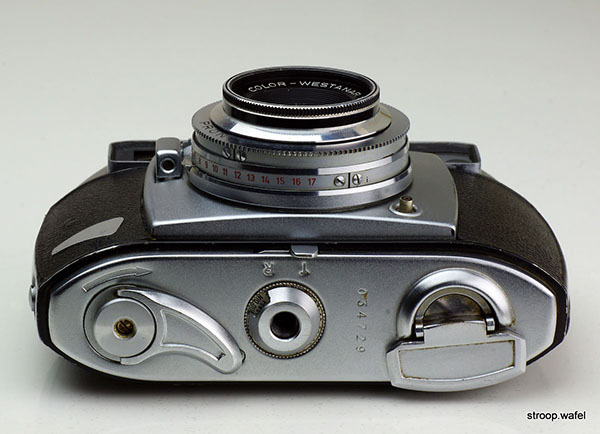
Bottom view of the Baldessa Ib with it unusual film wind key on the right and the rewind lever on the left. The latter pops up when pushing the lever, that doubles as a stand, from T to R. The film reminder is integrated in the tripod bush.
Baldamatic II
The Baldamatic was a range of cameras with coupled light meters, but otherwise similar to the Baldessa range. The Baldamatic II was a rangefinder camera with a parallax-corrected frame projected in the viewfinder. Also visible in the viewfinder were the lightmeter needle, the matching needle used to set the correct exposure settings as well as a small window showing the selected aperture. The latter was adjusted using a setting wheel just above the shutter release button under the viewfinder window. Hence, all exposure settings as well as lens focus could be monitored without taking one's eye from the viewfinder. One could even wind the film this whilst looking through the viewfinder, making the camera fast and convenient to use.
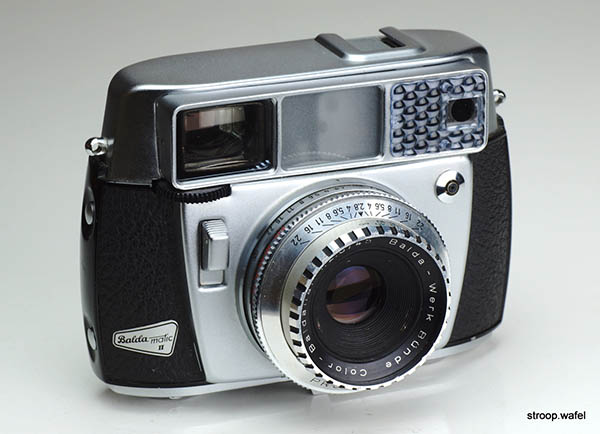
A Baldamatic II with Color-Baldanar 45mm f/2.8 lens in Pronto-LK shutter.
Baldamatic III
The Baldamatic III was unique amongst all Balda cameras, as it was the only model with an interchangeable lens mount, a Compur Deckel mount. This was the same mount also found on the Kodak Retina IIIS and most Reflex models, as well as the Iloca Electric and the Voightlander Vitessa T (although each mount was slightly different so lenses could not be interchanged). Available lenses included a Balda-Xenar 50mm f/2.8, a Balda-Xenon 50mm f/1.9 and a Balda Tele-Xenar 135mm f/4.
The Baldamatic had a coupled rangefinder and, like other Baldamatics, a coupled light meter. A wheel under the light meter was used to adjust the exposure, the light meter needle was visible in the viewfinder. The camera had the same quirky design as other Balda cameras from that era: a T-shaped winder on the base that needs to be twisted like a key and a rewind lever that released by pushing a lever.
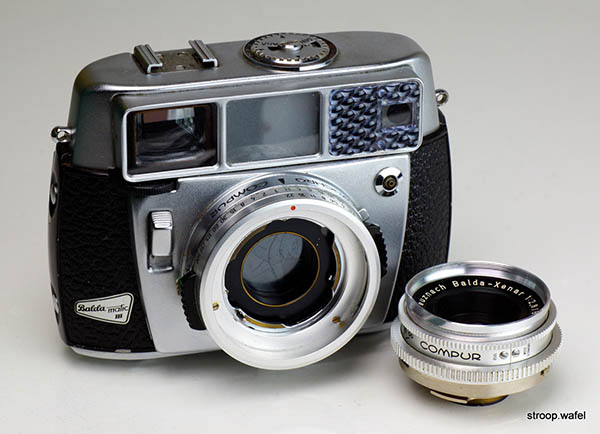
A Baldamatic III with interchangeable Compur mount and a Balda-Xenar 50mm f/2.8 lens.
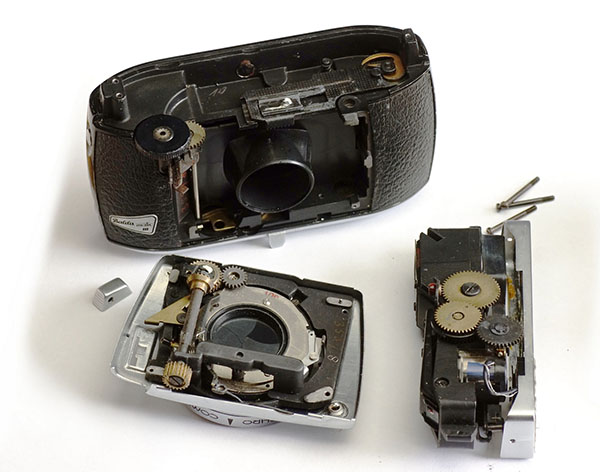
Partially dismantled Baldamatic III showing some of the exposure control gears as well as the shutter unit. For a simple cleaning of the shutter, this is how far one needed to go to get to it!
Balda Supermatic I
The Balda Supermatic range was very similarly styled as the Baldamatic range but featured a shutter priority auto exposure mode. One would select the desired shutter speed and the camera would adjust the aperture according the light levels as measured by the selenium exposure meter. A parallax-corrected frame was visible in the viewfinder window, which also showed the aperture selected. The camera could also be operated in fully manual mode.

A Balda Supermatic I with the same Color-Baldanar 45mm f/2.8 lens as on the Baldamatic II above, but in Compur shutter.
Balda microscope camera
It is a little known fact that many camera makers made technical cameras for use with microscopes or other technical equipment. Often these were based on existing camera bodies but without viewfinder and occasionally without shutters, making use of external shutters instead. Balda was no exception in making such technical cameras, an example of a microscope camera is shown below.

A Balda microscope camera with no lens and not even a shutter. It does not bear any Balda branding, but it is easily identifiable by the characteristic key for film winding. The shape of this key indicates this model is from around 1965, as it is the same as found on the later Baldessas, such as the RF. Earlier models like all the ones above had a (often lost) leather inlay on the key and a curved rewind crank.
| 
